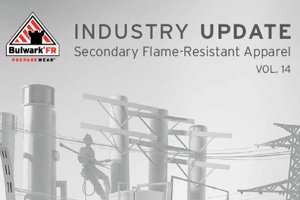 The following is an excerpt from Bulwark's Introduction to FR Apparel and Standards:
The following is an excerpt from Bulwark's Introduction to FR Apparel and Standards:
Do everyday wearing aparel and normal work clothes have the same flamability characteristics?
All are required to meet the same federal flammability standard:
16 CFR Part 1610.
The standard, administered by the Consumer Products Safety Commission, was originally adopted in 1954 as CS 191-53, the Flammable Fabrics Act. The purpose of the standard is to reduce the danger of injury and loss of life by providing, on a national basis, standard methods of testing and rating the flammability of textiles for clothing use. This standard does not apply to children’s sleepwear or protective clothing. The standard measures two fabric attributes: ease of ignition and speed of flame spread. A specimen mounted at a 45° angle is exposed to a one second ignition.
If the specimen ignites, the flame spread time is recorded. The Act establishes three classes of flammability based on ease of ignition and flame spread time.
What are the three classes of fabric flamability?
Class 1 Normal Flammability- 3.5 seconds or more. May or may not ignite when exposed to the standard 1 second ignition source.
Class 2 Intermediate Flammability- Does not apply to plain surface textile fabrics
Class 3 Rapid, Intense Burning- Less than 3.5 seconds, dangerously flammable, not suitable for clothing.
What class must garments manufactured or sold in the U.S. met?
All wearing apparel made from plain surface textile fabric and sold in the U.S. must be made of fabric rated Class 1.
No wearing apparel can be made of fabric rated Class 3.
Everyday wearing apparel will ignite and continue to burn if exposed to an ignition source. Normal work apparel is made from a range of fabrics similar to those offered as everyday wearing apparel. Just like everyday apparel, normal work apparel will ignite and continue to burn if exposed to an ignition source.
FAST FACTS
|
Is there a need for Flame-Resistant protective garments?
All fabrics made of untreated natural fibers and most synthetic fibers are combustible. It is normal and expected that they will ignite and continue to burn when exposed to an ignition source such as flame or electric arc. Because clothing constructed from these normal fabrics meets flammability requirements established by 16 CFR Part 1610, it is generally accepted as having no unusual burning characteristics.
Resistance to ignition and burning is an abnormal condition of wearing apparel. When work environments or occupations pose a risk of garment ignition and burning, flame-resistant apparel should be considered and selected.
How do non-FR fabrics react to ignition?
Non-FR fabrics and garments will burn away from the point of ignition with an increasing rate of flame spread and continue to burn after removal of the ignition source. Non-FR fabrics will continue to burn until they are extinguished or all flammable material is consumed.
How do FR fabrics react to ignition?
Flame-resistant (FR) fabrics and garments are intended to resist ignition, prevent the spread of flames away from the immediate area of high heat impingement, and to self-extinguish almost immediately upon removal of the ignition source.
Do FR garments prevent burn injury?
FR garments will not provide significant protection from burn injury in the immediate area of contact with the ignition source. However, flame-resistant garments do provide protection against clothing ignition and sustained flame spread.
What type undergarments should be worn?
National Fire Protection Association (NFPA) 70E, Standard for Electrical Safety in the Workplace, states that nonmelting, flammable fiber undergarments may be used in conjunction with FR garments. Flame-resistant t-shirts, henleys and base layer garments can provide additional wearer protection.
Are FR garments stil effective if contaminated with flamable substances?
Flammable substances on FR garments will ignite and continue to burn on the surface of the FR garment. Flame resistant garments should be immediately removed and replaced with clean FR apparel if they become fouled with flammable material. If laundering or dry cleaning cannot remove flammable contaminants, the contaminated garments should be removed from service.
Is 100% cotton fabric “flame-resistant”?
There is a common perception that untreated 100% cotton fabric is somehow “flame-resistant.” This is simply not true. While heavyweight untreated 100% cotton fabrics may be more difficult to ignite, they can and will ignite and continue to burn if exposed to an ignition source.
For more information on FR apparel, such as common causes of ignition, chemical resistance, arc rating, testing techniques and high visibility FR clothing, click here to download Bulwark's Introduction to FR Apparel and Standards.


